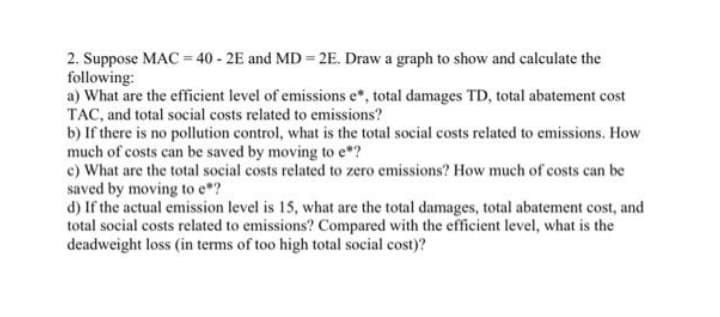2. Suppose MAC = 40 - 2E and MD = 2E. Draw a graph to show and calculate the following: a) What are the efficient level of emissions e*, total damages TD, total abatement cost TAC, and total social costs related to emissions? b) If there is no pollution control, what is the total social costs related to emissions. How much of costs can be saved by moving to e*? c) What are the total social costs related to zero emissions? How much of costs can be saved by moving to e*? d) If the actual emission level is 15, what are the total damages, total abatement cost, and total social costs related to emissions? Compared with the efficient level, what is the deadweight loss (in terms of too high total social cost)?
2. Suppose MAC = 40 - 2E and MD = 2E. Draw a graph to show and calculate the following: a) What are the efficient level of emissions e*, total damages TD, total abatement cost TAC, and total social costs related to emissions? b) If there is no pollution control, what is the total social costs related to emissions. How much of costs can be saved by moving to e*? c) What are the total social costs related to zero emissions? How much of costs can be saved by moving to e*? d) If the actual emission level is 15, what are the total damages, total abatement cost, and total social costs related to emissions? Compared with the efficient level, what is the deadweight loss (in terms of too high total social cost)?
Essentials of Economics (MindTap Course List)
8th Edition
ISBN:9781337091992
Author:N. Gregory Mankiw
Publisher:N. Gregory Mankiw
Chapter11: Public Goods And Common Resources
Section: Chapter Questions
Problem 10PA
Related questions
Question

Transcribed Image Text:2. Suppose MAC = 40 - 2E and MD = 2E. Draw a graph to show and calculate the
following:
a) What are the efficient level of emissions e*, total damages TD, total abatement cost
TAC, and total social costs related to emissions?
b) If there is no pollution control, what is the total social costs related to emissions. How
much of costs can be saved by moving to e*?
c) What are the total social costs related to zero emissions? How much of costs can be
saved by moving to e*?
d) If the actual emission level is 15, what are the total damages, total abatement cost, and
total social costs related to emissions? Compared with the efficient level, what is the
deadweight loss (in terms of too high total social cost)?
Expert Solution
This question has been solved!
Explore an expertly crafted, step-by-step solution for a thorough understanding of key concepts.
This is a popular solution!
Trending now
This is a popular solution!
Step by step
Solved in 4 steps

Knowledge Booster
Learn more about
Need a deep-dive on the concept behind this application? Look no further. Learn more about this topic, economics and related others by exploring similar questions and additional content below.Recommended textbooks for you

Essentials of Economics (MindTap Course List)
Economics
ISBN:
9781337091992
Author:
N. Gregory Mankiw
Publisher:
Cengage Learning

Principles of Microeconomics
Economics
ISBN:
9781305156050
Author:
N. Gregory Mankiw
Publisher:
Cengage Learning

Essentials of Economics (MindTap Course List)
Economics
ISBN:
9781337091992
Author:
N. Gregory Mankiw
Publisher:
Cengage Learning

Principles of Microeconomics
Economics
ISBN:
9781305156050
Author:
N. Gregory Mankiw
Publisher:
Cengage Learning